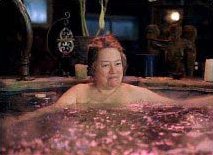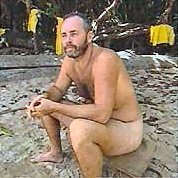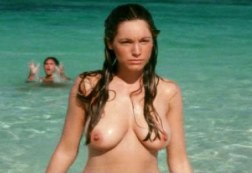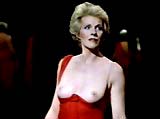
|
SCNA NUDIST FORUM
Return to Nudist Forum Menu |
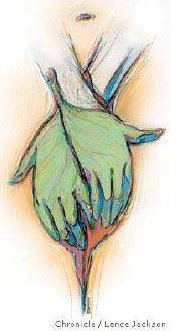 Chronicle illustration by Lance Jackson
|
Nudity in Movies and TV The Fig Leaves Are Falling!
In the opening scene of the hit movie Something’s Gotta Give, Jack Nicholson gets an eyeful as his 63-year-old character’s much younger girlfriend teasingly starts peeling off her clothes. Later on, in a farcical parallel, he stumbles in on his girlfriend’s middle-aged mother, played by Diane Keaton, who’s just undressed for bed. Both of them wince, squawk and run for cover. “I’ve never seen a woman that age naked,” the Nicholson character, Harry Langer, remarks to another man, as if recuperating from a shock.
As it turns out, that frightful nude scene is the real deal, a prelude to the first true love of Harry’s life. Something’s Gotta Give is a romantic comedy. As such, it blurs and burnishes reality for its own entertaining ends. But it also captures and distills a larger truth about contemporary life. Like Harry, people are opening up to nudity in surprising and liberating new ways. In the arts and in real life, the unclothed human form has moved from its traditional and limiting theme—sex—to embrace everything from aging and global politics to economics and social satire.
Nudity figures importantly in a spate of recent movies—including In the Cut, Calendar Girls , The Cooler and Something’s Gotta Give —but the trend stretches well beyond the big screen. From nude peace demonstrations during the Iraq war to Broadway’s empowerment musical The Full Monty, suburban families sunning on nude beaches to hot painter John Currin’s potently ambivalent canvases of enormously buxom young women and gaunt seniors—bare bodies of all ages, shapes and dispositions are everywhere, insisting they be seen in their own light.
Conceptual artist Spencer Tunick has seized the moment, traveling the world to photograph assemblages of up to 7,000 unclothed volunteers in public spaces. Tunick’s nude installation project was profiled recently in an HBO documentary. Once regarded as the province of the hard-bodied young (and nudist-colony fringe), nudity has grown more familiar and more broadly accepted in the culture. In doing so, it’s taken on a wider and more nuanced range of meanings. The classic purveyors of sexually arousing flesh, as a result, seem hopelessly out of phase. Middle-aged Playboy, in its 50th anniversary issue, is still proffering the shellacked, gravityconfounding pinups of a bygone vintage.
Even some of the newer, ostensibly hipper forms of erotically provocative nudity can now seem oddly stilted and silly. For all the public outrage the company stirred with its recent catalog filled with nude models and touting group sex, clothing retailer Abercrombie&Fitch’s imagery is often laughably contrived. Buff models chase one another around in the nude, smile vacantly, pile into castles or carriages or on top of each other in brazenly suggestive but strangely chaste arrangements carefully art-directed to disguise the most private parts.
Television is famously crowded with fully or partially nude folk these days. But here, too, brassy “reality” often comes off with a dully manufactured shine. On a recent episode of Blind Date, one of TV’s peekaboo dating shows, Bo kept telling Tiffany how comfortable he was with nudity. To prove it, as they strolled together on a beach, he yanked off his clothes and did a couple of back flips. A yellow “Censored” tag protected TV viewers from the full truth. “Oh my God, he did it,” Tiffany giggled. “This is one crazy, crazy guy.”
For TV viewers who can hardly avoid such eager, amateur strippers while channel surfing, Bo didn’t seem crazy in the least. He was just another deliberately, self-consciously naked guy. Contrast that with the casually integrated nudity that turns up on cable shows like The Sopranos or Sex and the City.
Take in the profusion of satirically mighty breasts in the current Supernova show of 1990s art at the San Francisco Museum of Modern Art. Some works, like Currin’s Laughing Nude, are arch and unsettling. Others, like Takashi Murakami’s cartoon bathing beauty sculpture (Hiropon) spraying a formidable orbit of milk from one giant nipple, conjure jarring notions of maternal superherodom. Or consider the witty and dramatically effective treatment nudity gets in two very different films.
Calendar Girls, loosely based on a true story, follows a group of late middle-aged women in a provincial English village who decide to raise money for a local hospital by posing for a nude calendar. On the surface, it’s a female Full Monty, full of giggles, abashment and the sudden body bravery of people taking control of their destiny. (Monty was about unemployed men who bare it all for cash at a strip club.) But Calendar Girls has more emplitude, from the sweetly elegiac episode that launches the plot to the moral dilemmas that divide the characters when their calendar becomes a runaway success. Before he dies of leukemia, one of the women’s husbands offers a quiet rhapsody about the last phase of a woman’s life as “the most gorgeous.”
The calendar project becomes a metaphorical realization of that belief, as the women pose before the camera in their workaday pursuits of cooking, gardening, flower arranging and piano practice. Nudity and the ongoing texture of real life are touchingly, comically fused. Complications of greed, jealousy and hypocrisy emerge and resolve later, as Hollywood and Jay Leno summon these unlikely new objects of desire, curiosity and goodwill. Calendar Girls offers only the most tactful glimpses of bare flesh. But its approach to nudity is vigorous and open-hearted.
Encased in his cheap suits, a thick flap of hair and defeatist scowl, William H. Macy is more ghost than corporeal being in The Cooler. When a pretty waitress (Maria Bello) comes on to this Vegas loser, he can’t quite fathom his uncharacteristic luck. It’s not what it seems, as many things aren’t in this dark fable of trial and redemption. The couple’s first nude love scene registers the movie’s shifting, elusive surface and underlying intensity to perfection.
Awkward, spasmodic, baffled and ravished by what’s just happened to him, Macy falls backward on the pillow. The camera swoops up to watch, then travels slowly down his body. Bello’s strategically placed hand both claims and protects his vulnerability. Either way, with her hand on his most tender part, she’s got him. Eventually, with images of his pouchy backside, graying chest hair and mottled skin seen in harsh morning light, Macy’s character acquires a kind of frank, primal drive. Seen this clearly, he seems to see himself and cast off his carapace of gloom. By the end, Macy’s emotional nakedness gleams even when he’s fully dressed.
The new nudity has evolved gradually over the years, driven by a variety of social forces. It began with the sexual revolution of the 1960s, marked by such Dionysian signposts as I Am Curious—Yellow on film and Hair and Oh! Calcutta! on Broadway.
The liberation movements of women and gays in the 1970s and ’80s expanded consciousness, made inroads on the objectification of women’s bodies and leveled the playing field. Men, too, could be naked—and not just to get the job done. Film, theater, advertising, the fashion industry and television endorsed and promulgated new notions of male beauty.
Not that it all went swimmingly. Nudity was a key battleground in the late 20th century culture wars. But once their shock effect settled down and settled in, the X-rated Midnight Cowboy, Robert Mapplethorpe’s graphically gorgeous photographs of homoerotic subjects and Karen Finley’s foodenhanced performance pieces enlarged the public conception of nudity in a culture that tended to toggle between Puritan reserve and prefabricated titillation. Hidden or buried ideas about the psychology of repression, body politics, violence against women and gays and more have gradually come out in the open.
We see and think about bodies more fully now, with wider implications, than before. First, with the triumph of the Internet, imagery
previously cordoned off has become almost universally accessible. Most cyber-nudity, to be sure, is pornography, much of it raunchy and raw. Dismaying as that fact may be to many observers, computers have undoubtedly democratized and demythologized nudity in the public marketplace, just as they do with other forms of information. For better or worse, nudity is ubiquitous on the Net—often tawdry, sometimes disturbing, occasionally funny and even instructive.
An aging Baby Boomer population determined not to age has also changed the nudity landscape. Thanks to aerobics, better nutrition, the decline of bad health habits, widespread plastic surgery and Botox—not to mention a strain of healthily undaunted egotism—bodies that used to decline in private remain on view much longer now. It adds up to a collective if you’ve-got-it-show it ethic. It no longer raises great controversy or even an eyebrow when middle-aged stars (Meg Ryan, Harvey Keitel, Kathy Bates, Frances McDormand, Julie Andrews) appear nude or partially nude. They’re just riding the prevailing cultural wind.
Nudity is and always has been about context, a reflection of time and place. All nudes, as critic Anne Hollander observes, wear “the ghosts of absent clothes,” the cloak of their own age. From the perfect union of body and soul invoked by ancient Greek vases to Rembrandt’s reverence for every fleshy lump and wrinkle to Henry Moore’s smooth abstractions, nudity has tracked human aspiration, ideas, anxieties and notions of mortality itself through the centuries.
“The nude does not simply represent the body,” as Kenneth Clark wrote in his 1956 landmark study, The Nude, but “all structures that have become part of our imaginative experience.” Living in the present automatically limits our ability to make sense of our own structures and experience.
Who’s to say, for example, that Unreasonable Women Baring Witness, the Marin County group that protested the Iraq war by spelling out nude slogans on a beach and pasture, is more serious—or frivolous—than the determined streakers of a generation past? And how will Kathy Bates’ barebreasted hot-tub scene in About Schmidt hold up over time? Playboy, according to Hugh Hefner, has another 50 years of glowing, glossy bodies to display. Anachronistically, he may be right.
This much does seem clear: Nudity has become a larger, more open and more inclusive issue in the culture. If that means that some of the erotic charge of secrecy and discovery is gone, it also enriches our appreciation of the deep and fascinating shadows that nudes inevitably cast.
The most telling thing about the nudity in Something’s Gotta Give is not the nudity itself—the eyeblink flash of Keaton in that one scene, the comical rear gapping of Nicholson’s hospital gown in another. It’s the fact that neither of them can stop talking about what his seeing her naked means. Part ice-breaker, part seminar topic and part verbal flirtation, it proves to be the unlikely igniter of romance. Once they’ve finally gotten the nudity out of the way, the two stars can get down to business and fall in love.
|
